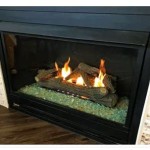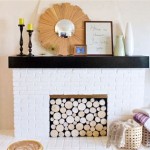Can You Paint a Brick Fireplace White? A Comprehensive Guide
Painting a brick fireplace white has become a popular interior design trend, offering a way to brighten a room, modernize the space, and create a focal point. The natural warmth and texture of brick can be preserved while updating the aesthetic to align with contemporary styles. However, painting brick is not an irreversible decision, and careful consideration should be given to the process and potential consequences before proceeding. This article will provide a comprehensive guide to painting a brick fireplace white, covering preparation, materials, application, and maintenance aspects, ensuring informed decisions and successful outcomes.
Assessing the Brick's Condition and Suitability
Before embarking on the project, a thorough assessment of the brick fireplace is crucial. The age, condition, and type of brick will influence the painting process and the longevity of the finish. Check for existing paint or sealant, water damage, efflorescence (white powdery deposits), soot buildup, and cracks. These issues need to be addressed before any paint is applied. If the brick is crumbling, excessively damaged, or shows signs of significant moisture problems, painting might not be the best solution. Repairing structural issues takes precedence over cosmetic enhancements. Consider the porosity of the brick; highly porous brick will absorb more paint and may require additional coats. Bricks with a smooth, sealant-like finish will require more rigorous surface preparation to ensure proper paint adhesion.
Furthermore, consider the architectural style of the home. In some historical homes, painting the original brick fireplace might detract from the overall character and value of the property. Weigh the aesthetic benefits against the potential impact on the home's historical integrity. Consult with design professionals or historical preservation societies if uncertainty persists. Documenting the condition of the brick before painting is also good practice for future reference.
Preparing the Brick Surface for Painting
Proper surface preparation is paramount for a successful and durable paint finish. Start by thoroughly cleaning the brick. First, remove any loose debris, dirt, or soot with a stiff brush and a vacuum cleaner. A wire brush may be needed for stubborn deposits but use it with caution to avoid damaging the brick. Next, wash the brick with a solution of trisodium phosphate (TSP) and water, following the manufacturer's instructions for dilution and safety precautions. TSP is a powerful degreaser and cleaner that will remove grime and prepare the surface for painting. Rinse thoroughly with clean water and allow the brick to dry completely, which may take several days depending on humidity and ventilation.
Address any existing problems before painting. Repair cracks or holes with masonry patching compound, ensuring it is compatible with the brick. If efflorescence is present, remove it with a wire brush and then apply a masonry cleaner specifically formulated to neutralize and remove the salt deposits. Allow the cleaner to dry completely before proceeding. If the brick has a glossy or sealed surface, consider etching the surface with a masonry etching solution to improve paint adhesion. Follow the manufacturer's instructions carefully and rinse thoroughly. Once the brick is clean, dry, and repaired, mask off surrounding areas with painter's tape and drop cloths to protect them from paint splatters.
Selecting the Right Paint and Primer
Choosing the appropriate paint and primer is essential for achieving a durable and aesthetically pleasing finish on a brick fireplace. Latex-based paints are generally recommended for interior brick surfaces due to their flexibility, breathability, and ease of cleaning. Acrylic latex paints offer good adhesion, durability, and resistance to cracking. Avoid using oil-based paints on brick, as they can trap moisture and lead to premature paint failure.
A high-quality masonry primer is crucial for sealing the brick and providing a good base for the paint. A primer designed for masonry will help to prevent the paint from being absorbed into the porous brick, ensuring even coverage and a longer-lasting finish. Consider using a stain-blocking primer if the brick has stains or soot residue that cannot be completely removed. Apply the primer according to the manufacturer's instructions, typically requiring one or two coats for optimal coverage. Allow the primer to dry completely before applying the paint. Choose a white paint that complements the overall design of the room; consider different shades of white, from bright white to off-white or cream, depending on the desired effect.
The paint finish should also be carefully considered. Matte or eggshell finishes are popular choices for brick fireplaces, as they provide a subtle, non-reflective look that emphasizes the texture of the brick. Semi-gloss or gloss finishes can be used to create a more dramatic and reflective effect, but they also tend to highlight imperfections in the brick surface. Select a paint with good scrubbability, as fireplaces may require occasional cleaning to remove soot and ash.
Applying the Paint and Subsequent Maintenance
Using the right tools and techniques will contribute to a professional-looking paint job. Use high-quality brushes and rollers designed for textured surfaces. A brush is necessary for getting into the mortar joints and corners, while a roller can be used to cover the larger, flat surfaces of the brick. Apply the paint in thin, even coats, avoiding drips and runs. Allow each coat to dry completely before applying the next. Typically, two coats of paint will be required for full coverage, but additional coats may be necessary depending on the porosity of the brick and the color of the paint.
After painting, allow the paint to cure completely before using the fireplace. Curing times vary depending on the paint type and environmental conditions, but generally, a week is recommended. Once the paint is cured, inspect the fireplace for any missed spots or imperfections and touch up as needed. Maintain the painted brick fireplace by regularly cleaning it with a soft cloth and mild detergent. Avoid using abrasive cleaners or scrubbing too vigorously, as this can damage the paint. Repair any cracks or chips in the paint as soon as they appear to prevent moisture from penetrating the brick. Reapply a fresh coat of paint every few years as needed to maintain the appearance and protect the brick.

Painting Brick Fireplace White A Renovation Story

How To Paint A Brick Fireplace What Use Home With Janny

How To Paint Your Fireplace Brick Surround

How To Paint A Brick Fireplace

How To Paint Your Brick Fireplace Katie Lamb

How To Prep Prime And Paint A Brick Fireplace Young House Love

Painting Our Brick Fireplace White Emily A Clark

How To Paint A Brick Fireplace

White Painted Brick Fireplace Makeover Jennifer Rizzo

Painting Brick Fireplace From White To Beautiful Brownstone Pretty Handy Girl
Related Posts








